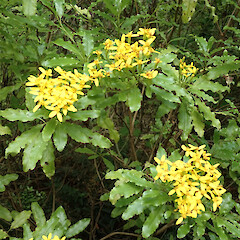Brachyglottis perdicioides
Common name
raukumara
Synonyms
Senecio perdicioides Hook.f., Senecio multinerve Colenso, Senecio distinctus Colenso, Senecio perdicioides var. distinctus (Colenso) Kirk., Brachyglottis perdicioides var. distincta (Colenso) B.Nord., Senecio tripetaloides Colenso
Family
Asteraceae
Flora category
Vascular – Native
Endemic taxon
Yes
Endemic genus
No
Endemic family
No
Structural class
Trees & Shrubs - Dicotyledons
NVS code
The National Vegetation Survey (NVS) Databank is a physical archive and electronic databank containing records of over 94,000 vegetation survey plots - including data from over 19,000 permanent plots. NVS maintains a standard set of species code abbreviations that correspond to standard scientific plant names from the Ngä Tipu o Aotearoa - New Zealand Plants database.
BRAPER
Chromosome number
2n = 60
Current conservation status
The conservation status of all known New Zealand vascular plant taxa at the rank of species and below were reassessed in 2017 using the New Zealand Threat Classification System (NZTCS) – more information about this can be found on the NZTCS website. This report includes a statistical summary and brief notes on changes since 2012 and replaces all previous NZTCS lists for vascular plants.
Please note, threat classifications are often suggested by authors when publications fall between NZTCS assessment periods – an interim threat classification status has not been assessed by the NZTCS panel.
- Conservation status of New Zealand indigenous vascular plants, 2017 . 2018. Peter J. de Lange, Jeremy R. Rolfe, John W. Barkla, Shannel P. Courtney, Paul D. Champion, Leon R. Perrie, Sarah M. Beadel, Kerry A. Ford, Ilse Breitwieser, Ines Schönberger, Rowan Hindmarsh-Walls, Peter B. Heenan and Kate Ladley. Department of Conservation. Source: NZTCS and licensed by DOC for reuse under the Creative Commons Attribution 4.0 International licence.
2017 | Threatened – Nationally Critical | Qualifiers: DP, RR, Sp
Previous conservation statuses
2012 | At Risk – Naturally Uncommon | Qualifiers: Sp
2009 | At Risk – Naturally Uncommon | Qualifiers: CD
2004 | Gradual Decline
Brief description
Rare small shrub inhabiting coastal scrub of the southern East Cape and Mahia. Leaves 2–5 cm long, pale green, paler underneath, margin roughly toothed and wavy. Flowers daisy-like with a few yellow, radiating petals, in loose clusters.
Distribution
Endemic. New Zealand: North Island (scattered sites from East Cape (Hicks Bay) to Mahia Peninsula).
Habitat
Coastal shrubland and forest - usually in open ground. Often forming cohorts within scrub.
Detailed description
Aromatic shrub 1–2 × 1 m. Trunk stout, bark pale to dark grey, peeling in small stringy flakes or shards. Branchlets numerous, spreading, slender and “twiggy”. Leaf buds resinous and sticky, finely covered in “cobwebbed” hairs. Petioles slender, 10–15 mm long. Leaves (10)–25–50–(70) × (15)–20–(25) mm, oblong to elliptic-oblong, finely crenate-serrate, dark green, to yellow-green with paler undersides, glabrescent with undersides usually covered in sparse “cobb webbed” hairs. Inflorescence a crowded corymb. Captitula (5)–12–20–(30), turbinate, borne on pubescent, somewhat resinous and sticky pedicels. Ray florets 1–3–(5), ligules oblong, yellow, 6–8 mm, apex sometimes bidentate. Phyllaries oblong, pale grey green, with a pubescent midrib, margins scarious. Seed a cypsela, pubescent or glabrescent, 2–2.5 mm, pappus-hairs stiff, 5 mm, finely barbellate.
Similar taxa
Brachyglottis pentacopa, which differs by the more numerous ray-florets (usually 5), and smaller, rounder leaves. However, there is some indication that these species intergrade, with some of the more southerly populations of B. perdicioides very similar to B. pentacopa. Accordingly some botanists informally treat B. pentacopa as a variety or subspecies of B. perdicioides, while others regard it as an absolute synonym. Further research into the matter is required.
Flowering
(October)–November–April–(May)
Flower colours
Yellow
Fruiting
(December)–January–April–(May)
Life cycle
Pappate achenes are dispersed by wind (Thorsen et al., 2009).
Propagation technique
Easy from fresh seed and semi-hardwood cuttings. A very hardy shrub which is tolerant of a wide range of habitats, soils types and moisture regimes.
Threats
Habitat loss appears to be main threat. However, recruitment appears limitng in some sites, possibly as a consequence of weeds which now often form a permnant ground cover in the places where seedlings would normally germinate. Established plants do not appear to be browsed by livestock, thus mature plants can persist in rough pasture.
Etymology
brachyglottis: Name comes from the Greek words brachus meaning “short” and glottis meaning “the vocal apparatus of the larynx”
perdicioides: Like perdicium, a groundsel from Chile
Where To Buy
Occasionally available from some specialist native plant nurseries.
Attribution
Fact Sheet Prepared for NZPCN by: P.J. de Lange (4 September 2004). Description adapted from Allan (1961).
References and further reading
Allan HH. 1961. Flora of New Zealand, Volume I. Indigenous Tracheophyta: Psilopsida, Lycopsida, Filicopsida, Gymnospermae, Dicotyledones. Government Printer, Wellington, NZ. 1085 p.
Thorsen MJ, Dickinson KJM, Seddon PJ. 2009. Seed dispersal systems in the New Zealand flora. Perspectives in Plant Ecology, Evolution and Systematics 11: 285–309. https://doi.org/10.1016/j.ppees.2009.06.001.
NZPCN Fact Sheet citation
Please cite as: de Lange, P.J. (Year at time of access): Brachyglottis perdicioides Fact Sheet (content continuously updated). New Zealand Plant Conservation Network. https://www.nzpcn.org.nz/flora/species/brachyglottis-perdicioides/ (Date website was queried)
















